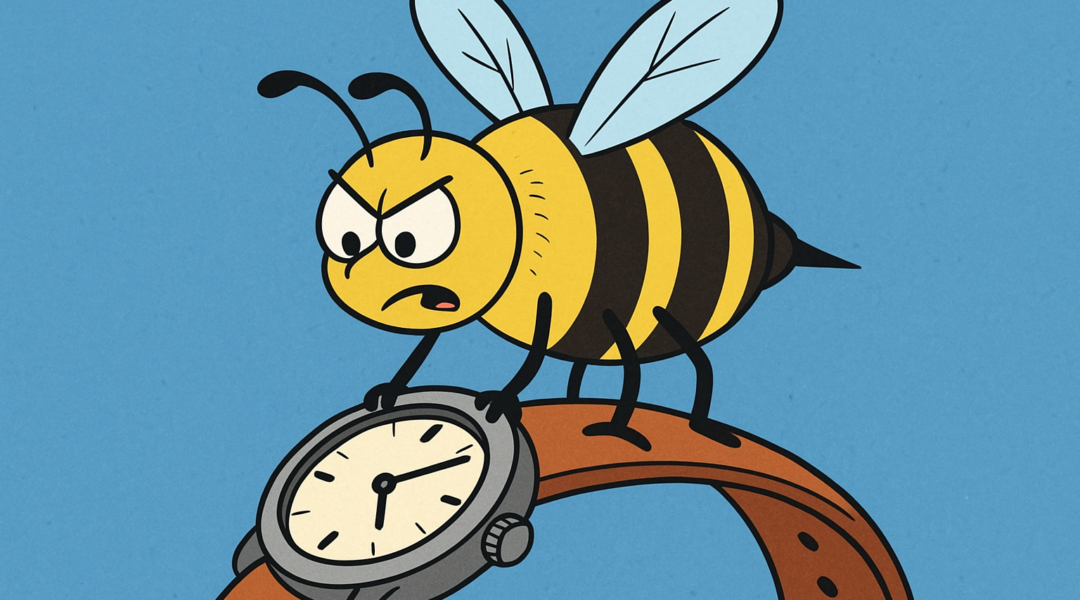From Bee Sting Video to Animation: Why Science Needs Both
My accidental bee sting video captured a detached stinger still pumping venom. Here’s why transforming this footage into animation would revolutionize how we understand nature’s most sophisticated weapon.
Coffee on the terrace. A bee lands on my watch. Then, in a split second, it’s gone – but its stinger remains, pumping like a tiny autonomous heart. What started as an accidental bee sting video revealed exactly why we need animation to truly understand this mechanism – much like how we use visual storytelling to explain complex science to investors and patients alike.
The Raw Footage: What My Bee Sting Video Shows
The bee sting video captures something remarkable: a completely detached organ continuing its mission. You can see the rhythmic contractions – about 1.5 to 2 pumps per second – as the venom sac empties itself into my watch band.
However, here’s what’s frustrating: this bee sting video can only show the surface. The real magic happens inside, where cameras can’t reach. Therefore, animation would transform our understanding completely.
(Also read:Functional anatomy of the worker honeybee stinger (Apis mellifera))
What Bee Sting Animation Would Reveal from Bee Sting Video
While my bee sting video shows external pumping, a proper animation would unveil hidden secrets:
The Hidden Mechanics
- Twin lancets moving in perfect opposition
- One-way valves preventing venom backflow
- Tiny barbs anchoring deeper with each stroke
- Neural circuits still coordinating everything
The Invisible Chemistry
Furthermore, a bee sting animation would visualize molecular action:
- Melittin molecules (50% of venom) destroying cell walls
- Phospholipase A2 amplifying the damage
- Histamine triggering swelling and redness
- Alarm pheromones calling for backup
Why Every Bee Sting Video Needs Animation Support
My footage proves the mechanism exists. Nevertheless, without animation, viewers can’t grasp several key concepts. First, they won’t understand why the stinger keeps pumping (autonomous neural circuits). Second, the venom’s path remains mysterious (it flows between lancets, not through them). Additionally, the barbed design’s effectiveness stays hidden from view.
The Medical Education Gap
Current Limitations
Medical students watching bee sting video see results but not processes. Although they learn about allergic reactions, the actual protein cascade remains abstract. Consequently, treatment understanding suffers.
What Animation Would Add
In contrast, a proper bee sting animation would show:
- Venom proteins binding to cells
- Mast cells releasing histamine
- Blood vessels becoming leaky
- Why epinephrine reverses these effects
Moreover, this isn’t just academic – understanding the mechanism saves lives.
Engineering Applications Hidden in Bee Sting Video
The Microinjection Revolution
Engineers studying my bee sting video can observe the pumping action. However, animation would reveal deeper insights. For instance, it would show how alternating lancet motion reduces insertion force by 90%. Similarly, the unidirectional barb design would become clear. Most importantly, engineers could see how to replicate autonomous pumping in medical devices.
Drug Delivery Innovation
Additionally, a detailed bee sting animation would demonstrate:
- Venom release along the entire shaft
- Pressure dynamics within the bulb
- Surface tension effects
- Capillary action principles
As a result, these insights would speed up painless injection development.
What Professional Bee Sting Animation Would Include
Level 1: Basic Mechanics
- External view matching the bee sting video
- Simple cutaway showing internal parts
- Clear labeling of components
Level 2: Dynamic Systems
Subsequently, the animation would progress to show:
- Lancet reciprocation in slow motion
- Venom flow patterns
- Barb engagement sequence
- Neural signal pathways
Level 3: Molecular Action
Furthermore, advanced sections would visualize:
- Protein structures and binding
- Cell membrane disruption
- Inflammatory cascade
- Pain signal transmission
Level 4: Medical Response
Finally, the complete animation would demonstrate:
- Immune system activation
- Antibody production
- Individual reaction differences
- Treatment mechanisms
The Research Value of Combined Media
Video Provides:
- Proof of autonomous function
- Real-time behavioral data
- Authentic timing reference
- Emotional connection
Animation Would Add:
On the other hand, animation brings:
- Internal mechanism clarity
- Multi-scale visualization
- Time manipulation ability
- Hypothesis testing visuals
Therefore, bee sting video and animation together would create total understanding.
Real-World Impact Potential
For Emergency Responders
Currently, training uses bee sting video to recognize reactions. However, animation would enhance this by showing why some stings cause severe reactions. Responders would see how venom spreads through tissue. Most critically, they’d understand intervention timing and why removal speed matters.
For Drug Development
Meanwhile, researchers analyzing bee sting video for pain medications need animation desperately. Visual models would help them identify receptor binding sites. Computer graphics could model drug modifications. Ultimately, this would lead to better targeted therapies.
For Patient Education
Similarly, showing patients bee sting video helps them understand events. Yet animation would explain their body’s overreaction clearly. Patients would grasp how allergy shots work. Above all, they’d understand why carrying EpiPens is vital.
The Technical Requirements for Bee Sting Video Analysis
Creating accurate bee sting animation from video requires several steps. First, motion tracking captures the original footage movement. Next, anatomical research provides structural accuracy. Then, electron microscopy data adds microscopic detail. Finally, experts validate the results.
Future Possibilities
AI-Enhanced Creation
In the near future, machine learning could transform bee sting video analysis. Computers could track stinger movement automatically. Subsequently, AI might generate preliminary animations. Eventually, software could predict internal mechanics and create educational variants instantly.
Virtual Reality Applications
Moreover, imagine stepping inside a bee sting animation. Users could walk through the venom delivery system. They’d watch proteins interact with cells firsthand. As a result, complex concepts would become intuitive through immersion.
The Call to Action
My accidental bee sting video captured something extraordinary. Nevertheless, without animation, it’s like having a treasure map without the key – tantalizing but incomplete.
Therefore, we need:
- Funding for professional science animation
- Collaboration between videographers and animators
- Standards for biological animation accuracy
- Channels for educational content sharing
Why This Matters
Every year, people die from bee stings due to misunderstanding. Some remove stingers too slowly. Others don’t recognize severe reactions. Meanwhile, many fear bees unnecessarily.
Consequently, a comprehensive bee sting animation based on real video would:
- Save lives through better education
- Inspire medical innovations
- Reduce unnecessary fear
- Promote bee conservation
The Vision
Imagine if every bee sting video included companion animation. Emergency rooms would gain better training tools. Furthermore, engineers would design superior medical devices. Patients would understand their conditions clearly. Most importantly, children would appreciate bees instead of fearing them.
That pumping stinger on my watch band represents millions of years of evolution – a mechanism so refined we’re still learning from it. While my video captured the phenomenon, we now need animation to explain it fully.
Because ultimately, understanding leads to innovation, and innovation saves lives. That’s precisely why every bee sting video deserves the animation treatment it needs to tell its complete story.
Wnat to find out more about how we animate science: Get in touch here.

